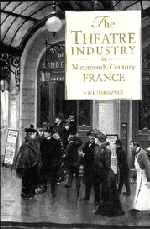Book contents
- Frontmatter
- Contents
- Chronology
- Introduction
- PART I THE AUDIENCES
- 1 Going to the theatre in the nineteenth century
- 2 The auditorium
- 3 Performance times – intervals – annual closures
- 4 First nights and previews
- 5 Order and disorder in the theatres
- 6 Applause and censure
- 7 The claque
- 8 Working-class audiences
- PART II THE ACTING PROFESSION
- PART III THE PROFESSION OF PLAYWRIGHT
- Notes
- Bibliography
- Guide to further reading
- Index
1 - Going to the theatre in the nineteenth century
Published online by Cambridge University Press: 07 December 2009
- Frontmatter
- Contents
- Chronology
- Introduction
- PART I THE AUDIENCES
- 1 Going to the theatre in the nineteenth century
- 2 The auditorium
- 3 Performance times – intervals – annual closures
- 4 First nights and previews
- 5 Order and disorder in the theatres
- 6 Applause and censure
- 7 The claque
- 8 Working-class audiences
- PART II THE ACTING PROFESSION
- PART III THE PROFESSION OF PLAYWRIGHT
- Notes
- Bibliography
- Guide to further reading
- Index
Summary
Before any theatre-goer fixes on where he is to spend his evening, he will probably want to know what play or plays are to constitute the entertainment at the theatre he proposes to visit. From the end of the seventeenth century onwards, the most usual means of informing the public about forthcoming theatre productions was by posters affixed at certain recognized sites throughout the city. In Paris these posters or playbills were of a standard size, printed in black on differently tinted paper: originally green for the Comédie-Française, pink for the Comédie-Italienne, and yellow for the Opera. Different shades were used by the minor theatres, but white paper was generally prohibited: a decree issued on 22 July 1791 by the National Assembly and still in force reserves black on white for notices issued by the authorities.
These theatre posters, at any rate down to the fall of the Empire, had little to do with publicity as the word is understood today. Their discretion and modest dimensions struck a British traveller in 1814 as being ‘perhaps the only thing in Paris calculated to make an Englishman blush for the opposite practice of his country. It is a mortifying contrast to the impudent quackeries and lying pretensions which, in all the varieties of a large and small letter, are blazoned on the handbills of our two national theatres.’
- Type
- Chapter
- Information
- The Theatre Industry in Nineteenth-Century France , pp. 9 - 27Publisher: Cambridge University PressPrint publication year: 1993



